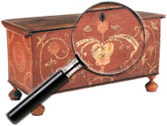|
|
Collection of Florence P. and William W. Griffin
Bill and Florence Griffin met at an Atlanta Bird Club meeting in 1945. Bill was a published amateur ornithologist; Florence was interested in all of nature – she knew the names of all the plants as well as the birds.
Both were from Georgia, and soon began to see their state changing before their eyes as the New South swept away the Old. They quickly became [...] Click here to continue reading.
Just about any culture with paper has a form of paper-cutting decoration, but establishing much of the history is tricky because of the fragile, ephemeral nature of paper. Still, we know that China and Japan were practicing paper-cutting very early, and the usage depends on the culture. In Japan, paper-cutting was used to create decorations for the home, while in Jewish and Eastern European cultures, the cuttings often had a religious theme. The [...] Click here to continue reading.
Zao Wou-Ki (French/Chinese, 1921 to 1913)
Zao Wou-ki occupies a pivotal role in the artistic dialogue between East and West. A seminal figure in 20th century art, Zao studied with Lin Fengmian at the National Academy of Arts in Hangzhou in the 1940s before moving to Paris in 1947. Zao has since called France his home, and his influential career developed in that dynamic, cosmopolitan environment. Paris was still the capital of world culture [...] Click here to continue reading.
Sitting Bull, Sioux Chief (circa 1831 to 1890)
Sitting Bull, the man who would later become the Hunkpapa Sioux chief, was born in South Dakota, near the Grand River. His Lakota name was Tatanka-Iyotanka. In his thirties, he began to build his reputation as a warrior, leading war parties in Red Cloud’s War against a number of Dakota Territory forts. Although the U.S. negotiated with the Sioux in order to end the war and [...] Click here to continue reading.
John James Audubon (1785 to 1851)
John James Audubon was born in Haiti on April 26, 1785 on a sugar plantation, the son of Lt. Jean Audubon, a French naval officer, and Audubon’s mistress, Jeanne Rabin, a Louisiana chambermaid. After the death of Jeanne Rabin and a slave uprising that convinced Audubon’s father to give up his holdings in the colony, John James Audubon, still a toddler, and his younger sister returned to France [...] Click here to continue reading.
Wilbur G. Adam (1898-1973)
A Cincinnati native and a decorated artist during his career, Wilbur Adam’s work has rarely surfaced on the market and has fallen into obscurity in recent years.
Collectors intimately familiar with the early 20th century school of Cincinnati artists might be surprised at Adam’s work and his association with many of the Queen City’s notables- including Frank Duveneck, Herman and Bessie Wessel, Lewis Henry Meakin, and Caroline Lord, to [...] Click here to continue reading.
The Sarcophagus in Decorative Arts
Derived from the Greek sarx, meaning flesh, and phagein, meaning eat, a sarcophagus is, essentially, a container for a body, much like a coffin or casket. Historically, sarcophagi were typically made of stone (though sometimes of other materials, such as wood or metal), with a relief-carved or pediment top, and designed to be above ground, and have been used by many cultures since ancient times.
An ancient [...] Click here to continue reading.
Charles Marion Russell (1864-1926)
Charles Russell was as famous for his personal character as he was for his artistic career. A simple and modest man, he left the Midwest to pursue a life on the frontier. While residing primarily in Montana for the remainder of his life, Russell, or “Cowboy Charlie”, went on to become the state’s favorite son and achieve great renown for his depictions of the American West.
An [...] Click here to continue reading.
Panoramic Views
Accurately rendering a panoramic view has long challenged, obsessed and inspired artists. The trend seems to have sprung up in the 17th century, with works that served both as slightly more helpful, more detailed maps with various public or important buildings marked, but also as advertisements for towns and cities. Matthaeus Merian, a Swiss engraver who spent most of his career in Frankfurt, where he also ran a publishing house passed to [...] Click here to continue reading.
Hoosier and the Hoosier Group
The word “Hoosier” is one of those words whose origins are lost to time. Even The Oxford English Dictionary offers no real guidance about where the word came from. What we do know is that “Hoosier” was first documented in the mid-1820s, and within a decade, it had entered general usage. John Finley, a Hoosier himself from Richmond, write a poem titled, “The Hoosier’s Nest” that was published in [...] Click here to continue reading.
|
Recent Articles
- Charles Alfred Meurer – American Artist & Tromp L’Oeil Artist
- Sendak, Maurice – American Artist & Writer
- Godie, Lee – American Artist
- Davis, Vestie – American Artist
- Bartlett, Morton – American Artist
- Mackintosh, Dwight – American Artist
- Evans, Minnie Jones – African-American Artist
- Mumma, Ed (Mr. Eddy) – American Artist
- Nice, Don – American Artist
- Savitsky, John (Jack) – American Artist
- Gordon, Harold Theodore (Ted) – American Artist
- Dial, Thornton – African-American Artist
- Doyle Sam – American Artist
- Johnson, Lester Frederick – American Artist
- Finster, Howard – American Artist
|
|
